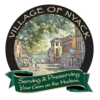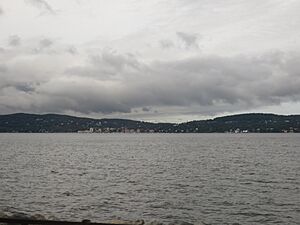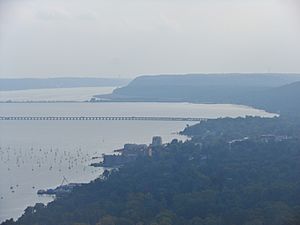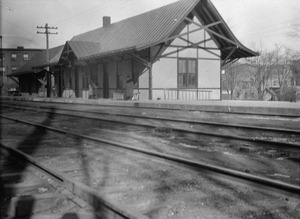Nyack, New York facts for kids
Quick facts for kids
Nyack, New York
|
||
|---|---|---|

Main Street in Downtown Nyack
|
||
|
||
| Motto(s):
Art & Soul on the Hudson
|
||
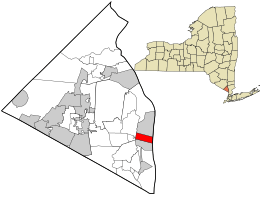
Location in Rockland County and the state of New York.
|
||
| Country | United States | |
| State | New York | |
| County | Rockland | |
| Incorporated | February 27, 1883 | |
| Area | ||
| • Total | 1.61 sq mi (4.16 km2) | |
| • Land | 0.77 sq mi (1.99 km2) | |
| • Water | 0.84 sq mi (2.16 km2) | |
| Elevation | 72 ft (22 m) | |
| Population
(2020)
|
||
| • Total | 7,265 | |
| • Density | 9,435.06/sq mi (3,643.36/km2) | |
| Time zone | UTC-5 (Eastern (EST)) | |
| • Summer (DST) | UTC-4 (EDT) | |
| ZIP code |
10960
|
|
| Area code(s) | 845 | |
| FIPS code | 36-54100 | |
| GNIS feature ID | 0959074 | |
| Website | www.nyack.gov | |
Nyack (pronounced NIGH-ack) is a small village in Rockland County, New York. It's mostly in the town of Orangetown, with a tiny part in Clarkstown. In 2020, about 7,265 people lived there.
Nyack is a suburb of New York City. It's about 15 miles north of Manhattan, right by the Hudson River. It's located north of South Nyack, east of Central Nyack, and south of Upper Nyack.
Contents
- About Nyack: Location & Neighbors
- Nyack's Past: A Look Back in Time
- Nyack's Geography: Where is it?
- Nyack's People: Who Lives Here?
- Getting Around: Transportation in Nyack
- Cool Places to Visit: Landmarks in Nyack
- Historical Markers: Learn More About Nyack
- Education in Nyack
- Famous People from Nyack
- Images for kids
- See also
About Nyack: Location & Neighbors
Nyack is one of five villages and hamlets called "The Nyacks." These include Nyack, Central Nyack, South Nyack, Upper Nyack, and West Nyack. The village is named after the Native American people who lived here long ago.
Nyack has many low-rise buildings on hilly land near the Hudson River. The Tappan Zee Bridge connects South Nyack across the Hudson River to Tarrytown in Westchester County. This bridge is a very important road for people traveling to and from work.
The village covers about 1.6 square miles. More than half of this area is actually part of the Hudson River. Nyack is part of the Nyack Public Schools district.
Nyack's Past: A Look Back in Time
Native American tools and oyster shells found along the Hudson River show that Nyack was a popular fishing spot before Europeans arrived. The first Europeans settled here in 1675. They called the area "Tappan."
Harman Douwenszen is believed to be the first European settler. He came to America as a child. In 1687, he asked to buy land in Tappan where he had lived for 12 years. His request was granted, and he bought the land from the Native Americans. He named his farm New Orania. This part of Nyack became known as Orangetown in 1683. The name "Nyack" comes from the Algonkian word "Nay-ack," which means "the fishing place."
A plaque in Nyack says: "The Tappan Indians lived on these lands by the river. Here, in summer, they fished and ate oysters. In their language, they called this place NAY-ACK, meaning the fishing place. The first white settlers came in 1675, when Harmen Dowesen (Tallman) moved here."
The Tallman family built a mill on a stream called Mill Brook. Nyack officially became an incorporated village in 1872.
Nyack once had three main industries:
- Quarrying: Digging up sandstone for buildings in New York City (around 1800–1840).
- Boat building: Making sloops, steamboats, pleasure boats, and even submarine chasers during World War I and II (around 1915–1948).
- Shoe manufacturing: Making shoes (around 1828–1900).
When the Northern Railroad of New Jersey came to Nyack in the mid-1800s, the village grew quickly. People decided they needed a village government to handle the community's needs. Some residents in the northern part of Nyack formed their own village, called Upper Nyack, to avoid higher taxes. Then, Nyack village was officially formed without that northern part. Later, people in the southern part of Nyack also wanted their own village, so they formed South Nyack. The area between Upper Nyack and South Nyack then became Nyack again.
Nyack also had a minor league baseball team called the Nyack Rocklands from 1946 to 1948. They were sometimes called the "Rockies."
Throughout the 1700s and 1800s, Nyack was known for building ships and was the main business center of Rockland County. The Erie Railroad connected Nyack to Jersey City, New Jersey. From there, ferries took passengers to New York City until 1966. When the Tappan Zee Bridge opened in 1955, Nyack's population grew, and its businesses expanded.
In the 1980s, the village worked to improve its downtown area and grow its economy. The Helen Hayes Theatre was built, and many new businesses opened.
In 1991, there was a famous court case about a house in Nyack. The court decided that a house at 1 LaVeta Place was "legally haunted." The owner had to tell future buyers about it. The owner, Helen Ackley, had even talked about the hauntings in a magazine. After she sold the house, there were no more reports of ghosts.
On August 10, 2010, the Highland Hose Company No. 5, a fire station on Main Street, celebrated 100 years in its building. The firehouse was built in 1910. Their 1949 Ahrens-Fox fire engine is still used today!
Nyack's Geography: Where is it?
Nyack covers about 1.6 square miles. About 0.8 square miles is land, and the other 0.8 square miles is water, mostly from the Hudson River.
Nyack is on the west bank of the Hudson River, just north of the Tappan Zee Bridge. The village is also home to Hook Mountain and has many hills, especially along the river's edge.
Nyack's People: Who Lives Here?
| Historical population | |||
|---|---|---|---|
| Census | Pop. | %± | |
| 1870 | 3,438 | — | |
| 1880 | 3,881 | 12.9% | |
| 1890 | 4,111 | 5.9% | |
| 1900 | 4,275 | 4.0% | |
| 1910 | 4,619 | 8.0% | |
| 1920 | 4,444 | −3.8% | |
| 1930 | 5,392 | 21.3% | |
| 1940 | 5,206 | −3.4% | |
| 1950 | 5,889 | 13.1% | |
| 1960 | 6,062 | 2.9% | |
| 1970 | 6,659 | 9.8% | |
| 1980 | 6,428 | −3.5% | |
| 1990 | 6,558 | 2.0% | |
| 2000 | 6,737 | 2.7% | |
| 2010 | 6,765 | 0.4% | |
| 2020 | 7,265 | 7.4% | |
| U.S. Decennial Census | |||
In 2000, there were 6,737 people living in Nyack. The population was a mix of different backgrounds. About 63.8% were White, 26.3% were African American, and 2.4% were Asian. About 8.6% of the population was Hispanic or Latino.
The average age in the village was 38 years old. About 19% of the people were under 18 years old.
Getting Around: Transportation in Nyack
Roads in Nyack
Nyack is located along the New York State Thruway. This road is also part of Interstate 87 and Interstate 287. It's just north of the Tappan Zee Bridge, which is now called the Governor Mario M. Cuomo Bridge. Other important roads include U.S. Route 9W and New York State Route 59.
Trains and Buses
Nyack used to have train service on the Northern Branch of the Erie Railroad. You could take a train to Jersey City and then a ferry to New York City. This train service stopped in 1966. Now, the old train line is a walking path.
Today, the closest train stations are in Tarrytown (about 8 miles away) and Nanuet (about 5.8 miles away).
Nyack has bus service called the Lower Hudson Transit Link (also known as Hudson Link). This bus connects Nyack to train stations in Tarrytown and White Plains. There are also buses that go to New York City. Local buses are provided by Transport of Rockland.
Cool Places to Visit: Landmarks in Nyack
- Edward Hopper House Art Center – This was the home of the famous painter Edward Hopper. It was built in 1858. One room shows things about Hopper's life and art. Other rooms show art by local artists. In the summer, you can enjoy jazz concerts in the garden. This building is on the National Register of Historic Places.
- First Methodist Episcopal Church of Nyack – This church was built in 1812–1813. It is also on the National Register of Historic Places.
- John Green House – Built in 1817, this is the oldest house still standing in Nyack. John Green started the first lumber yard and store in Nyack. It's a private home now.
- Memorial Park – This park is a short walk from downtown. It has a playground, a skateboard park, tennis courts, a basketball court, and a butterfly garden. You can launch canoes and kayaks into the Hudson River from here. The park also hosts summer music concerts, festivals, and outdoor movies.
- Nyack Library – This library building was built in 1903 as a Carnegie Library.
- Nyack Post Office – This building was built in 1932. It's a good example of the Classical Revival style of architecture. It serves Nyack, South Nyack, and Upper Nyack. It's on the National Register of Historic Places.
- Nyack-Tarrytown Ferry – The ferry started in 1834. It ran until the Tappan Zee Bridge opened in the 1950s. This spot was also the start of the Nyack Turnpike, the first direct highway across Rockland County.
- Oak Hill Cemetery – This cemetery opened in 1840. Many important people are buried here, including novelist Carson McCullers, playwright Charles MacArthur, actress Helen Hayes, and artist Edward Hopper.
- Pickwick Bookshop – This local bookstore has been open since 1945. It sells both old classic books and new bestsellers.
- Red Cross Center – This building was built in 1882 and given to the Red Cross in 1915. During World War I, World War II, and the Korean War, it was a busy place for collecting food, blood, clothes, and supplies for soldiers overseas. Today, it still helps people in need and offers courses like first aid.
- River Rowing Association (RRA) – Founded in 1881, this group is dedicated to sculling (rowing with two oars).
- Riverspace Arts in Nyack – This is where the Rockland Symphony Orchestra performs.
- St. Paul's United Methodist Church – This church was built in 1894 in the Romanesque Revival style. It's on the National Register of Historic Places.
- Pretty Penny – This beautiful Victorian home was once owned by actress Helen Hayes and comedian Rosie O'Donnell.
Historical Markers: Learn More About Nyack
- First Milestone from Nyack, Route 59 and Mountainview Avenue, Central Nyack
- Couch Court, 46 South Broadway
- Edward Hopper House Art Center, 82 North Broadway
- First Reformed Church, 18 South Broadway
- Historic Underground Railroad, 298 Main Street
- Historic Underground Railroad, 176 Main Street
- Memorial Park, Piermont and DePew Avenues
- Liberty Street School, Cornerstone Placement, Depew Avenue near Liberty Street
- Nyack First Settlement, 17 South Broadway
- Nyack Library, 59 South Broadway
- Oak Hill Cemetery, 140 North Highland Avenue
- "Pretty Penny," 235 North Broadway
Education in Nyack
Nyack Public Schools serves the village of Nyack. Nyack High School is the main high school here.
- In 2018, Niche's ranked Nyack Public Schools as the 68th Best School District in Nyack.
- In 2021, Nyack Schools changed their mascot from the Indians to the Redhawks.
Nyack was also home to Nyack College, a Christian college. The Roman Catholic Archdiocese of New York used to operate St. Ann Parish School in Nyack, but it closed in 2003.
Famous People from Nyack
- Joseph Alessi, classical trombonist
- Stephen Baldwin, actor
- Thomas Berger, novelist
- Coheed and Cambria, rock band formed in 1995 in Nyack
- Joseph Cornell, artist and sculptor
- Welles Crowther, a 9/11 hero
- John Francis Daley, actor, writer, and director
- Jonathan Demme, director
- Audric Estimé, Denver Broncos running back
- Terrence Fede, Miami Dolphins defensive end
- Ryan Grant, NFL running back
- Bill Gunn, playwright and director
- Helen Hayes, actress
- Matt Hennessy, NFL center
- Edward Hopper, painter
- Sakina Jaffrey, actress
- Zita Johann, actress
- Van Johnson, actor
- Mondaire Jones, first openly gay Black congressman
- Mike Kellin, actor
- Chuck Loeb, jazz musician
- Charles MacArthur, playwright
- James MacArthur, actor
- Devin McCourty, New England Patriots starting safety
- Jason McCourty, Miami Dolphins starting cornerback
- Carson McCullers, author
- Toni Morrison, author
- Rosie O'Donnell, talk show host and actress
- Jansen Panettiere, actor and artist
- Regret the Hour, Indie rock band
- Norman Rose, actor
- Jim Shooter, comic book writer
- Fabrizio Sotti, jazz guitarist
- Glynis Sweeny, cartoonist
- Sub Urban, musician
- Robert Ward, composer
- Sarah Weeks, author
Images for kids
See also
 In Spanish: Nyack para niños
In Spanish: Nyack para niños


